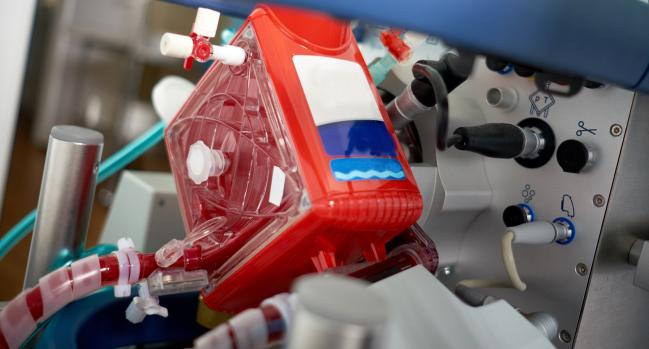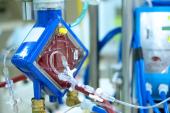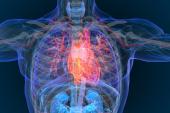Routine ECMO in AMICS Patients Not Protective: ECLS-SHOCK
(UPDATED) With no gain in 30-day survival and no signs of subgroups that benefit, clinicians may need to rethink mechanical support.

In patients with acute MI complicated by cardiogenic shock (AMICS) who are slated to undergo early revascularization, routine use of extracorporeal membrane oxygenation (ECMO) doesn’t reduce 30-day mortality. The negative findings, from the randomized ECLS-SHOCK trial, were released today at the European Society of Cardiology (ESC) 2023 Congress and simultaneously published in the New England Journal of Medicine.
Lead investigator Holger Thiele, MD (Heart Center Leipzig at University of Leipzig, Germany), speaking in an ESC press conference, described the lack of survival benefit as “disappointing.” He said the results will likely give clinicians—including himself—pause when deciding how best to manage this risky scenario.
After the IABP-SHOCK II trial, also led by Thiele, failed to show an advantage for use of an intra-aortic balloon pump, the field has leaned toward use of the Impella percutaneous left ventricular assist device (Abiomed) and ECMO, also known as extracorporeal life support (ECLS)—despite the absence of supportive data from large randomized trials, Thiele stressed.
Thiele told TCTMD that these new results should inspire introspection among clinicians. “If you ask me, ECLS-SHOCK leaves us in a situation where we have to rethink what we are doing. The steep increase in the use of mechanical circulatory support with [venoarterial] ECMO, maybe also with Impella devices, is not justified. Maybe it is too simplistic that a machine being able to provide some hemodynamic support is able to reduce mortality,” he explained in an email.
Jane A. Leopold, MD (Brigham and Women’s Hospital, Boston, MA), and Darren B. Taichman, MD, PhD (University of Pennsylvania, Philadelphia), writing in an NEJM editorial, ask the key question: “Will the results of the ECLS-SHOCK trial change current clinical practice?”
The answer, for them, isn’t monolithic. “If the goal of ECLS is to improve 30-day mortality, these data should steer interventional and critical care cardiologists away from its early routine implementation for all or even most patients with myocardial infarction and cardiogenic shock. There will be some patients in this population for whom ECLS is necessary and lifesaving, but the results of the ECLS-SHOCK trial do not tell us which ones,” they comment. “For now, the best course may be to reserve the early initiation of ECLS for those patients with infarct-related cardiogenic shock in whom the likely benefits more clearly outweigh the potential harms. We need further studies to tell us who they are.”
If you ask me, ECLS-SHOCK leaves us in a situation where we have to rethink what we are doing. Holger Thiele
During an ESC Hot Line session, Thiele presented results for 417 AMICS patients (median age 63 years; 81.3% men) in whom revascularization was planned. ECLS-SHOCK researchers randomized these participants to receive ECMO plus usual medical treatment or, as a control, the usual medical treatment alone. The multicenter trial took place at 44 hospitals in Germany and Slovenia, with participants recruited from June 2019 to November 2022. By design, it only enrolled patients thought most likely to benefit from ECMO: those with lactate levels above 3 mmol/L.
Crossover between the two study arms was discouraged, though patients in the control group could receive escalated therapies under certain circumstances—ultimately, 15.4% of controls received mechanical circulatory support via Impella, most commonly the CP model, and 12.5% received ECMO. In the ECMO group, 8.1% did not receive their assigned hemodynamic support.
Overall, two-thirds of patients presented with STEMI, two-thirds had multivessel disease, and for nearly half, the infarct-related artery was the LAD. Three-quarters underwent cardiopulmonary resuscitation prior to being randomized. Median lactate level before revascularization was 6.9 mmol/L, and all were in SCAI SHOCK stage C or higher.
At 30 days, the all-cause death rates were 47.8% with ECMO and 49.0% for controls (P = 0.81). Patients in the ECMO group spent longer on mechanical ventilation (median 7 vs 5 days). Nearly a quarter (23.4%) of the ECMO-treated patients had moderate or severe bleeding, as compared with 9.6% of controls (relative risk 2.44; 95% CI 1.50-3.95), and peripheral vascular complications warranting intervention occurred more often in the ECMO group, at 11% versus 3.8% (relative risk 2.86; 95% CI 1.31-6.25). Stroke rates did not differ between the ECMO and control arms.
Additionally, lactate levels were similar in the two groups through 48 hours, as were eGFR and SAPS-II scores through 7 days.
Why Didn’t It Work?
In their paper, the ECLS-SHOCK investigators speculate on several reasons why ECMO failed to have a positive effect. “First, the risk and associated device-related complications may counterbalance any potential benefit,” they suggest, adding that the days spent on mechanical ventilation may have had an impact. Moreover, insertion of ECMO is linked to potentially harmful higher LV afterload, the researchers note. The trial had predefined criteria for when LV unloading should occur, but it was done in just 5.8% of ECMO cases, Thiele pointed out. “Importantly, there are no data from RCTs that provide us with evidence that routine unloading strategies are able to reduce the mortality.”
Alaide Chieffo, MD (Vita-Salute San Raffaele University and IRCCS San Raffaele Scientific Institute - Milan, Italy), the trial’s discussant, summed up various characteristics that could have influenced its negative outcome.
With few exclusion criteria, the “almost all-comers cardiogenic shock trial” enrolled not only STEMI and NSTEMI but also across the SCAI SHOCK spectrum from classic to deteriorating and extreme, she noted. The study included patients who’d had cardiac arrest and were resuscitated within 45 minutes as well as those who’d been diagnosed with cardiogenic shock up to 12 hours prior to randomization. Moreover, lactate levels in reality were much higher than the 3-mmol/L threshold set by investigators, and the use of mechanical circulatory support in the control arm muddies the waters, she added.
Other procedural factors include the timing of ECMO as well as the “very low rate of loading of the left ventricle,” which Chieffo suggested could indeed impact mortality.
And finally, she asked, “What about having as an endpoint total mortality at 30 days? Is 30-day all-cause mortality a good endpoint to evaluate the efficacy of a device which is not a cure but a bridge to opportunity?” Future trials could perhaps look at recovery or endpoints that are more patient oriented, said Chieffo.
These are exactly the kinds of patients [for whom] we believe that maybe mechanical support devices work, and you showed us otherwise. Roxana Mehran
Roxana Mehran, MD (Icahn School of Medicine at Mount Sinai, New York, NY), co-moderator for the ESC Hot Line session, called ECLS-SHOCK a “monumental study.”
“It is a negative trial: you showed it, you did it, you did a beautiful job. . . . You were inclusive in including true cardiogenic shock with high lactates. These are exactly the kinds of patients [for whom] we believe that maybe mechanical support devices work, and you showed us otherwise,” she commented.
No Subgroups Stand Out
Whether there might still be subsets of patients who stand to benefit is unclear, said Thiele. In the current trial, there were no differences found based on sex, age, diabetes, NSTEMI versus STEMI, type of STEMI, arterial lactate level, or use of CPR.
A meta-analysis of individual patient data from ECLS-SHOCK and three smaller randomized trials, presented by Thiele at ESC and published in the Lancet, also failed to show a reduction in 30-day mortality or identify any promising subgroups.
“If you ask me, if there is any subgroup, then this subgroup is extremely small,” said Thiele. “Maybe it is the group of young patients with acute hemodynamic worsening in the cath lab who have a fast recovery by ECLS. But this needs to be proven in RCTs.”
Another question hinging on randomized trial results is whether the Impella device can benefit patients with AMICS. No conclusions on this matter can be drawn from ECLS-SHOCK, Thiele cautioned. “We will have to wait for the DanGer trial, which has enrolled [its] last patient only a few weeks ago.” The results from that long-anticipated study, he added, could be published next year.
At the moment, in Germany and likely elsewhere, ECMO is being overused, said Thiele. As for what he’s doing in his own day-to-day practice based on the results of ECLS-SHOCK, “it’s still under discussion, honestly. It will be difficult. We will have to digest what we have seen,” he said.
Caitlin E. Cox is News Editor of TCTMD and Associate Director, Editorial Content at the Cardiovascular Research Foundation. She produces the…
Read Full BioSources
Thiele H, Zeymer U, Akin A, et al. Extracorporeal life support in infarct-related cardiogenic shock. N Engl J Med. 2023;Epub ahead of print.
Leopold JA, Taichman DB. Routine early ECLS in infarct-related cardiogenic shock? N Engl J Med. 2023;Epub ahead of print.
Zeymer U, Freund A, Hochadel M, et al. Venoarterial extracorporeal membrane oxygenation in patients with infarct-related cardiogenic shock: an individual patient data meta-analysis of randomised trials. Lancet. 2023;Epub ahead of print.
Disclosures
- Thiele is president of the German Cardiac Society.





Paul Stein